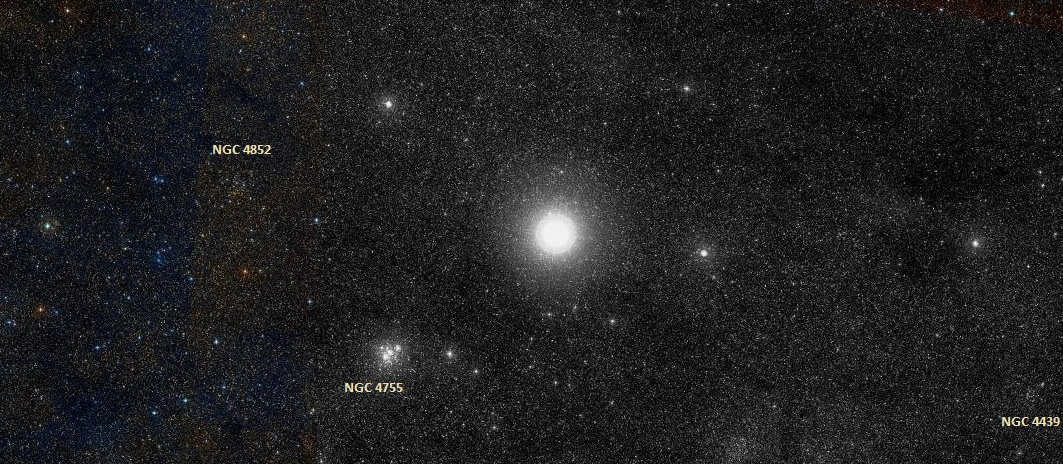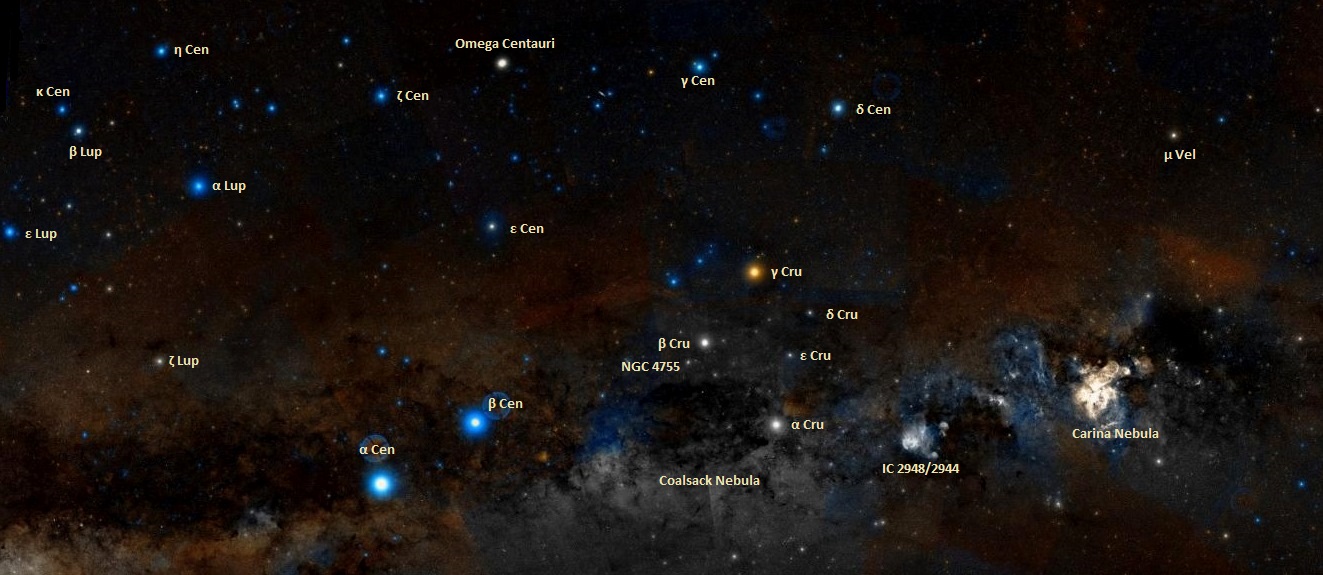Mimosa, Beta Crucis (β Cru), is a multiple star system located in the constellation Crux. With an apparent magnitude of 1.25, it is the second brightest star in Crux and the 20th brightest star in the sky. It is only slightly fainter than Pollux in the constellation Gemini, Fomalhaut in Piscis Austrinus and Deneb in Cygnus, but outshines Regulus in Leo, Adhara in Canis Major and Castor in Gemini.
Mimosa lies at a distance of 280 light years from Earth. Also known as Becrux, it is one of the four bright stars that form the Southern Cross, one of the most familiar asterisms in the southern sky.
Star type
Beta Crucis is a spectroscopic binary star system composed of a pair of stars that complete an orbit every 5 years (1,828 ± 2.5 days) at a separation between 5.4 and 12 astronomical units. The estimated age of the system is 8 to 11 million years.
The primary star, Beta Crucis A, has 16 solar masses, which seals its fate as a supernova in a few million years, and a radius 8.4 times that of the Sun. With an estimated temperature of 27,000 K, it shines with 34,000 solar luminosities, but most of its energy output is in the invisible ultraviolet part of the spectrum. The companion, Beta Crucis B, has an estimated mass 10 times that of the Sun.
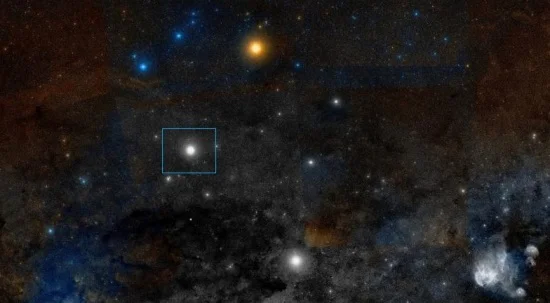
Mimosa (Beta Crucis), image: Wikisky
Both are class B stars, appearing blue-white in colour. The primary component has the spectrum of a giant, while the companion is still on the main sequence, fusing hydrogen in its core. Their given spectral types are B0.5 III and B2V.
The primary component is classified as a Beta Cephei variable. Like its Crux neighbour Imai and Hadar in Centaurus, it shows small variations in brightness as a result of pulsations of its surface. The star has three different pulsation modes with periods between 4.03 and 4.59 hours. Beta Cephei stars are typically slightly cooler. With a temperature of 27,000 K, Mimosa is at the edge of the instability strip where these stars are found.
Mimosa has a powerful stellar wind with an estimated velocity of 2,000 km/s-1. As a result, it is losing 10-8 solar masses per year, or about one solar mass every 100 million years.
In 2007, a third component of the Beta Crucis system was discovered by a team of researchers at Swarthmore College in Pennsylvania by accident, while they were trying to determine how the supersonic stellar winds of luminous stars produce X-rays. Instead of finding only one strong X-ray source, they detected two. The companion is believed to be a pre-main sequence star, still in the process of forming. The low-mass star was not detected in visible wavelengths, but through its X-ray radiation in a survey using the Chandra X-ray Observatory. It lies at a separation of 350 or more astronomical units from the main pair and takes at least 1,600 years to complete an orbit.
There are two other visual companions at separations of 44 and 370 arcseconds, but they are not believed to be gravitationally bound to the system. They most likely just lie in the same line of sight.
Facts
Mimosa was discovered to be a spectroscopic binary system by the German astronomer Wulff-Dieter Heintz in 1957.
A 2011 study by A. C Rizzuto and colleagues determined that Mimosa was 73% likely to belong to the Lower Centaurus-Crux subgroup of the Scorpius-Centaurus Association, the nearest OB association to the Sun. Like its neighbour Acrux, Mimosa has a similar age, position and motion through space as the members of the Scorpius-Centaurus group, and likely shares the same origin.
With an effective temperature of 27,000 K, Mimosa is the hottest first magnitude star. Spica, the luminary of the constellation Virgo, comes in second with 25,300 K and is followed by Mimosa’s neighbours Hadar with 25,000 K and Acrux with 24,000 K. Acrux B is considerably hotter than all these stars with a temperature of 28,000 K, but with an apparent magnitude of 1.75, it does not quite make it into the first magnitude group.
In ancient times, the stars of the Southern Cross were visible north of latitude 40°N, but have since sunk below the horizon for most northern observers due to the precession of the equinoxes. In ancient Greece and Rome, the stars of Crux were considered to be part of the larger constellation Centaurus.
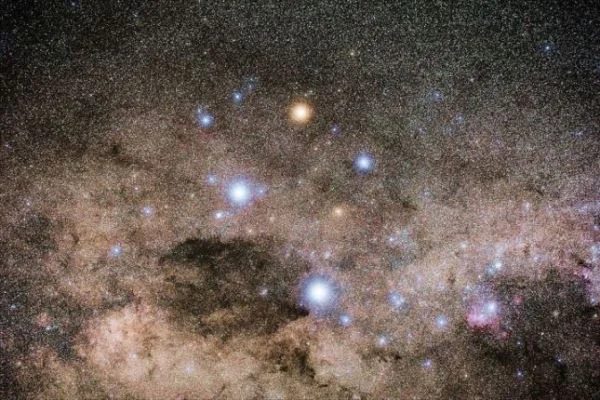
Wide field image of the Southern Cross, credit: Wikimedia Commons/Naskies (CC BY-SA 3.0)
The Southern Cross carries cultural significance in many countries in the southern hemisphere. It is represented on the flags of Australia, New Zealand, Brazil, Papua New Guinea and Samoa. On the Brazilian flag, each star represents a Brazilian Federative Unit and Mimosa symbolizes the state of Rio de Janeiro.
Name
Mimosa comes from the Latin word for “mime” or “actor.” It is unclear whether or not the star was named after the flowering plant of the same name. The name was officially approved by the International Astronomical Union’s (IAU) Working Group on Star Names (WGSN) on July 20, 2016.
The star’s other name, Becrux (pronunciation: /ˈbeɪkrʌks/, is a contraction of its Bayer designation, Beta, and the name of the constellation to which it belongs, Crux.
The Chinese name for the star is 十字架三 (Shí Zì Jià sān), meaning the Third Star of Cross. The Chinese Cross asterism consists of the four stars of the Southern Cross: Acrux, Mimosa, Gacrux and Imai.
Location
At about -60° declination, Beta Crucis cannot be seen from locations north of latitude 30°N.
To observers in southern latitudes, Beta Crucis is very easy to find because it is bright and part of the Southern Cross. The Southern Cross is easy to identify, as two exceptionally bright stars, Alpha and Beta Centauri (known as the Southern Pointers), point in its direction. A line from Alpha through Beta Centauri leads toward Gacrux, the star at the top of the Cross, and Mimosa is the star nearest to the Southern Pointers.
Mimosa can be used to find one of the brightest and finest open clusters in the sky. The Kappa Crucis Cluster, also known as the Jewel Box and designated NGC 4755 in the New General Catalogue, stretches across 10 arcminutes of the sky and lies only a degree southeast of the star, just outside the Cross asterism. The open cluster NGC 4852 in Centaurus constellation and NGC 4349 and NGC 4439 in Crux are also located in the vicinity of the star.
Constellation
Mimosa is located in Crux, the smallest constellation in the sky. In spite of its size, Crux is one of the most conspicuous southern constellations, and the Southern Cross, formed by the constellation’s brightest stars, plays an important role in many cultures south of the equator.
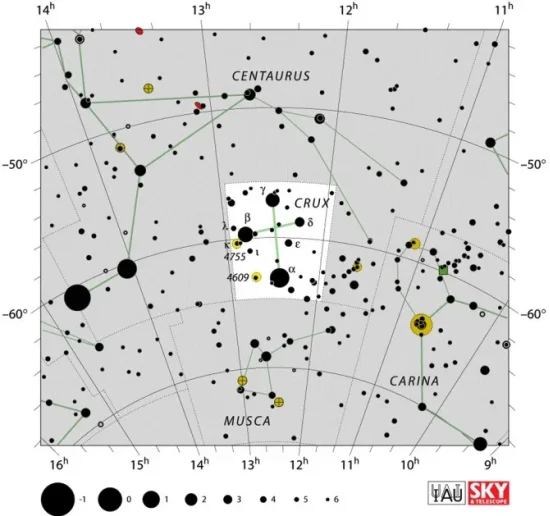
Crux constellation map by IAU and Sky&Telescope magazine
The best known deep sky objects in the constellation are the Kappa Crucis Cluster, one of the youngest open clusters known, and the Coalsack Nebula, a dark cloud of dust and gas more than 30 light years across, that blocks some of the light of the Kappa Crucis Cluster stars. The Coalsack Nebula can be seen between the cluster and Acrux, the star at the base of the Southern Cross. It crosses the border into the constellations Centaurus and Musca.
The best time of year to observe the stars and deep sky objects in Crux is during the month of May.
The 10 brightest stars in Crux are Acrux (Alpha Cru, mag. 0.76), Mimosa (Beta Cru, mag. 1.25), Gacrux (Gamma Cru, mag. 1.64), Imai (Delta Cru, mag. 2.79), Ginan (Epsilon Cru, mag. 3.58), Mu1 Crucis (mag. 4.03), Zeta Crucis (mag. 4.04), Eta Crucis (mag. 4.14), Theta1 Crucis (mag. 4.30), and Lambda Crucis (mag. 4.602).
Mimosa – Beta Crucis
| Spectral class | B0.5 III / B2V |
| U-B colour index | -0.98 |
| B-V colour index | -0.23 |
| Apparent magnitude | 1.25 (1.23 – 1.31) |
| Distance | 280 ± 20 light years (85 ± 7 parsecs) |
| Parallax | 11.71 ± 0.98 mas |
| Radial velocity | +15.6 km/s |
| Proper motion | RA: -42.97 mas/yr |
| Dec.: -16.18 mas/yr | |
| Age | 8 – 11 million years |
| Constellation | Crux |
| Right ascension | 12h 47m 43.26877s |
| Declination | –59° 41′ 19.5792″ |
| Designations | Mimosa, Becrux, Beta Crucis, β Cru, HD 111123, HR 4853, HIP 62434, FK5 481, SAO 240259, CPD−59°4451, EUVE J1247-59.6, CCDM J12478-5940A, GC 17374, GCRV 7661, IRAS 12448-5925, 2MASS J12474326-5941194, PPM 341305, TYC 8659-3107-1 |
Beta Crucis A
| Spectral class | B0.5 III |
| Variable type | Beta Cephei |
| Mass | 16 M☉ |
| Luminosity | 34,000 L☉ |
| Radius | 8.4 ± 0.6 R☉ |
| Temperature | 27,000 ± 1,000 K |
| Metallicity | -0.08 dex |
| Age | 8 – 11 million years |
| Rotational velocity | 35 km/s |
| Surface gravity | 3.6 ± 0.1 cgs |
Beta Crucis B
| Spectral class | B2V |
| Mass | 10 M☉ |
